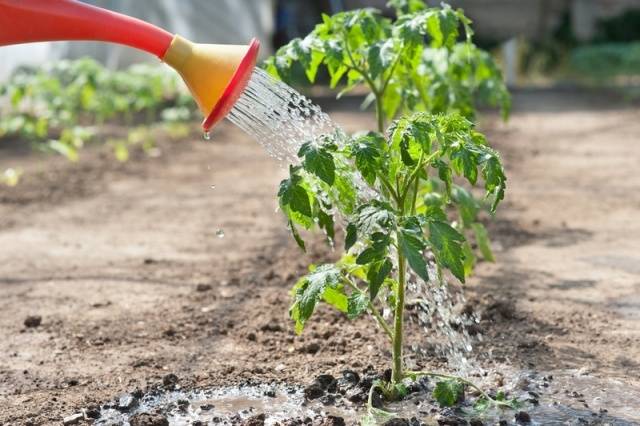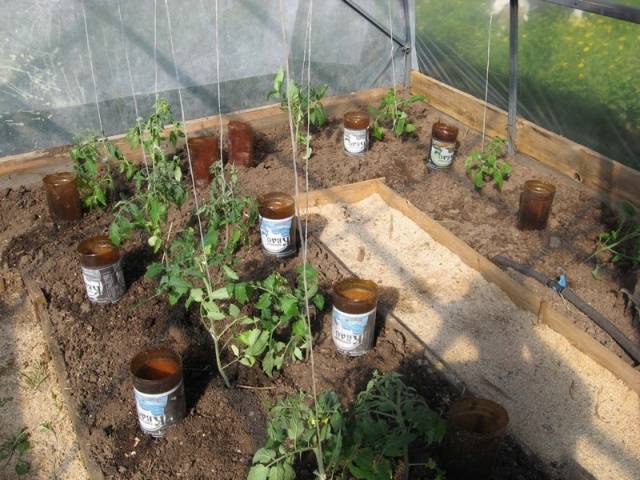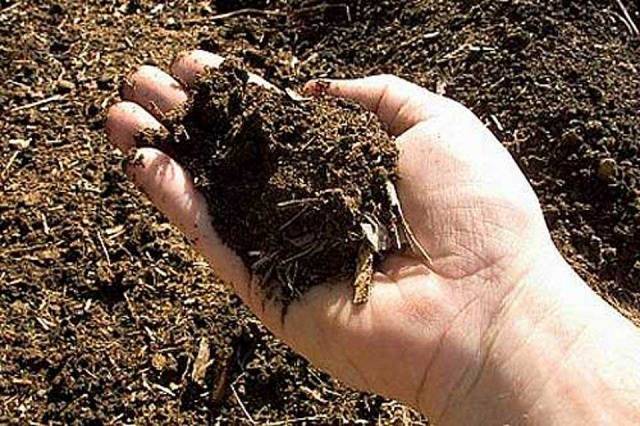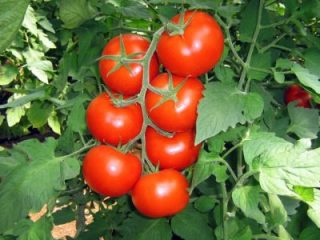Content
The yield of tomatoes and other vegetable crops directly depends on proper care. One of the components tomato care is their irrigation. Not many gardeners know that too much watering for plants of the nightshade family is even more dangerous than drought - this leads to fungal diseases of tomatoes, rotting of bushes, and cracking of fruits.
Find out in this article how to properly water tomato seedlings and what you need to know about these plants so as not to harm them.
Watering frequency
How often to water tomato seedlings largely depends on the age of the plants. Of course, important factors are the composition of the soil, climatic and weather conditions, and the variety of tomatoes, but the age of the seedlings still plays a major role in determining the watering schedule.
The root system of young plants, as well as their need for water, is significantly less than that of adult bushes that have reached their maximum height. At the same time, young tomato seedlings will die faster from lack of moisture, since their weak and small roots are located close to the surface. And the roots of adult tomatoes can go deep into the ground to a distance of about 150 cm - so deep there is almost always moisture, the plant can live without watering for some time.
So, we can determine the following rules for watering tomato seedlings at various stages of their “life”:
- After the soil for sowing tomato seeds has been prepared and abundantly watered, the sprouted seeds are planted in it. The seeds are dropped in with a thin layer of dry soil, covered with film and left in this position until the first shoots appear. During this period of time, there is no need to water the soil in containers and pots with seeds at all.
- When the first shoots appeared, the film cover was removed, and 2-3 days passed, the pipping of green sprouts should become widespread - all the seeds, or most of them, germinate and thin loops appear above the surface of the ground. During this period, tender seedlings cannot be watered - their roots will easily be washed out of the soil. If the soil in containers with seedlings is too dry, you can carefully spray the seedlings with a spray bottle or a small watering can for indoor flowers.
- At the stage of the appearance of the first pair of true leaves, tomato seedlings are watered as needed - when the soil in the pots becomes dry and crusty. As before, they use a spray bottle for watering and irrigate only the soil between the tomatoes, being careful not to wet the delicate bushes themselves.
- After two or three true leaves have grown tomato seedlings are picked. Two to three days before this event, the first fertilizing with fertilizers is applied along with watering. This will help soften the soil and make the saturated soil looser - the seedlings can be easily removed from the boxes, their roots will not be damaged when diving.
- After picking, tomatoes do not need to be watered for 4-5 days. Even if the seedlings look lethargic and sick, they do not need to be watered during this period of time. By adding water to the soil, the gardener will make it even more difficult for the tomato to adapt to its new habitat.
- After five days, you can begin to water the tomatoes according to the standard scheme, primarily focusing on the dryness of the soil in the pots. On average, bushes should be irrigated at least once a week; sometimes seedlings will have to be watered twice a week or ten days. Here, a lot depends on the temperature and humidity in the room with the seedlings, as well as on the amount and intensity of sunlight that dries out the soil.
- When the tomato seedlings reach the required height and gain strength (about 1.5-2 months after sowing the seeds), they are transferred to a permanent place: in a greenhouse or in a garden bed. Before transplanting tomatoes, water them generously for a couple of days - this will help remove the roots of the seedlings from the pot without damaging them.
How and how to water tomatoes
Not only do you need to water tomato seedlings on time, you also need to do it correctly.
First of all, you need to comply with the following requirements for the water with which tomatoes are watered:
- The water temperature should be at least 20 degrees. The optimal value is 23 degrees Celsius. If tomatoes are irrigated with cold water, the seedlings will begin to get sick, first of all, this is fraught with infection of the plants by late blight.
- Rain or melt water is most suitable for watering tomatoes. At the very least, such water should be used while the seedlings are small - this way the tomatoes will become much healthier, leaves and ovaries will form faster, and the bushes will become strong and powerful.
- Only soft water is suitable for watering tomatoes. Tap liquid is not suitable for irrigating tomato seedlings - it contains too many impurities, which makes it hard and unsuitable for plants. You can soften the water by boiling - this option is suitable for tomato seedlings. When the plants grow up and move into the greenhouse or garden beds, boiling such volumes of water will become problematic. In this case, the water can simply be settled for several days, collecting it in tanks or barrels.
- All fertilizing and feeding of tomato bushes is best done together with watering, so fertilizers or stimulants must be diluted in water.
No less important is how and how to add life-giving moisture to the tomato bushes. The main thing here is not to wet the stems and leaves of the plants, because they can easily pick up a fungal infection due to excessive humidity and hypothermia, or the seedlings will be burned by too bright rays of the sun through the drops on the leaves.
To prevent this from happening, you need to water the tomatoes at the root, and best of all, between the rows. This can be done at first with a small watering can, then irrigation can be done using a garden hose.
You can set up a drip irrigation system with your own hands. To do this, you will need ordinary plastic bottles, in which small holes are made across the entire surface. The bottom of the bottle is cut off and the neck is screwed on with a cap.
Bottles are buried in the ground near each tomato bush, bottom up. Water is poured into the bottle, and it gradually seeps through the holes, irrigating the root system of the tomatoes.
In this way, you can stimulate the growth of the root system, because the roots will tend downward towards moisture. In any case, pots and cups with tomato seedlings must have drainage holes, otherwise the plants will simply rot.
How to determine the need to water tomatoes
As already mentioned, tomatoes need to be watered based on the degree of dryness of the soil. Not every gardener, especially a beginner, will be able to determine from the top layer of soil in pots with seedlings how often to water tomato seedlings.
They will help simple ways to determine dry soil:
- The color of dry soil is somewhat duller than that of wet soil. Therefore, if the soil in the cups with seedlings is gray and lifeless, it’s time to moisten it.
- In order to check the soil moisture in deeper layers, you can use a wooden stick (similar to how you check the readiness of a pie).
- It is very convenient for the same purposes to use a metal wire, the end of which is bent with a hook. The length of the wire should be about 30 cm. It is immersed in the ground near the walls of the pot with tomato seedlings and carefully pulled out back. If the soil sticks to the hook, it means it is still wet enough and there is no need to water the tomatoes yet.
- Another accurate way is to dig up a lump of earth at a depth of 10 cm and try to make a ball out of it. If the soil is moldable, it is moist enough. When the lump is broken, the soil should crumble and crumble, otherwise the soil is too waterlogged, and the tomato watering schedule needs to be adjusted.
- If you lift a pot of seedlings, you can figure out its weight - dry soil weighs much less than wet soil.
- By tapping the walls of a pot of tomatoes with a stick or pencil, you can determine the soil moisture by sound: dry soil will give a ringing sound, while wet soil will “sound” more dull.
In accordance with the data obtained on the basis of such “research”, it is possible to adjust the irrigation regime and the amount of water.
How much water do tomatoes need?
The amount of moisture required by tomato bushes directly depends on the plant development cycle:
- While the seedlings are in the house, it needs a small amount of moisture, because plants “live” in a limited space - a pot or glass. To moisten such a minimal amount of soil, you won’t need a lot of water; another thing is that moisture will also evaporate from a small container faster.
- Before flowering Tomatoes need to be watered 5-6 liters per square meter of land.
- During the flowering period tomatoes need moisture most of all, so at this time the amount of water increases approximately three times - every meter is irrigated with 15-18 liters of water.
- When the fruits set and begin to fill, watering is reduced - low-growing tomatoes at this stage need only 5 liters per square meter, and tall varieties need at least 10 liters.
Regardless of the method and mode of watering, the soil around the tomato bush should be moistened to a depth of at least 10-15 cm (depending on the height and branching of the tomato bush).
The “fate” of this crop depends on how to water tomato seedlings, because, like all plants, first of all, tomatoes need moisture. Watering tomato seedlings should be carried out according to a schedule; these plants do not like chaos; they are equally harmed by both drought and excessive moisture.



















